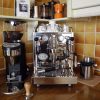I couldn’t make any scientific sense out of the accepted knowledge and reasons for the Coffee Beans degassing CO2. I read a lot about the various reactions that happen during roasting, but very little about what happens post roast and I actually think the time after roasting and what you do to the coffee is critical. I thought I might also share the results here.
When I use the term vacuum packing, I do not mean keeping the beans under reduced pressure, but rather using a flexible bag from which all excess air is sucked out of using a Vacuum pump. Packing the beans in what I would term a “hard” vacuum e.g. rigid container, I think would not be good for coffee. The hard container stores coffee under reduced pressure, a flexible bag does not.
I have performed a number of experiments, which I am sure could easily be reproduced, using the “vacu seal” packaging system, basically a flexible, reusable one way valve bag, from which all the air can be sucked out forming a coffee brick. To summarise the key points of my findings.
1. If you vacuum pack coffee after roasting, less gas is produced than would be produced in a 1 way valve bag (and I have packed 1000s of 1 way valve bags)
2. If you get the coffee vacuum packed ASAP after roasting and I mean as soon as it’s just cool enough to pack (5 mins after roasting), then the coffee will hardly degass for quite a while. I have Daterra and Mexican Topacio in my cupboard both Med-Med Dark roasted. They were packed 42 hours ago and vacuumed, both plastic bags are still “coffee bricks”, the coffee has produced almost no gas.
3. If the coffee is kept in the bags and re-vacuumed each time you take some out, then new CO2 is formed as the beans degass, if you keep re-vacuuming (without removing any more coffee) the coffee will again stop degassing after a few days and the bag will remain a solid brick…..you can leave this bag as a solid brick for 3 or 4 days, open it and take some coffee out, re-vacuum…. and it starts to degass again1
4. Flavour development does not seem to be impaired, the important reactions for flavour development that occur within coffee seem to happen in the absence of oxygen. I also believe oxygen to be incredibly damaging to the compounds that impart many of the flavours to coffee.
5. The smell of “oldness” is not present in the coffee even after 18 days if kept vacuum packed or re vacuumed after use (although in the second scenario, it does degrade faster)
6. The coffee extracts exactly as you would expect it too after normal resting periods.
7. The flavour of the coffee is noticeably better, the difference is so great that it is easily detectable by anyone who knows the particular coffees and how they should taste.
8. The bags store very neatly.2
The only conclusion that I can reasonably make is that Roasting coffee produces compounds that in the presence of oxygen will produce CO2. If the supply of Oxygen is limited, CO2 production is reduced (in some cases drastically). The CO2 is not actually present within the coffee itself in any significant quantity. The degassing process will go on as long as there are compounds in the coffee subject to oxidation reactions, even if the coffee is weeks old and degassing appears to have stopped because of vacuum packing.
Much more information about what I have been doing and how is posted in the Wiki, and I strongly recommend you consider trying this technique. I should also stress that I don’t use this as a method of extending the keeping time of coffee, but rather lifting the sweet spot and extending the period of time the sweet spot lasts although it would surely extend the keeping time of the coffee.







